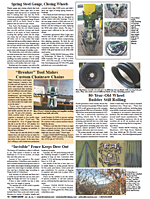1996 - Volume #20, Issue #1, Page #17
[ Sample Stories From This Issue | List of All Stories In This Issue | Print this story
| Read this issue]
Paddle Boat Made From Deere Swather
 |
 |
 |
Nowadays he still uses Deere equipment but in a different way. He converted a 10 1/ 2 by 31-ft. flatbed boat into a "John Deere" paddle boat by using components off an old Deere 2320 self-propelled swather. The swather's gas engine and hydraulic system power the wheels which are fitted with 4-ft. wide paddle wheels that Deering made from the batts on the original swather reel. The engine mounts behind the boat's cabin just ahead of the paddle wheels.
Made entirely of steel, the boat has no rudder. Instead, the paddles do the steering. They can be stopped or started independently and will even turn in opposite directions, which spins the boat around in its tracks. In other words, the boat steers like the original swather.
The boat is painted Deere green and yellow. Deering uses it to catch mussels in the nearby Tennessee river. At the front of the boat is a pair of 14-ft. long steel pipes fitted with a number of chains with hooks on them. An electric winch turns the pipes, lowering the hooks into the water. Then he chugs the boat along at a slow idle, catching mussels by dragging the chain hooks along the bottom of the river.
"The boat works great and draws a lot of attention," says Deering, who used the boat for the first time last March. "People wave and some stop to take photos. Most want to know if the boat is really powered by the Deere engine or if it's just for looks."
Deering moved the swather's frame and wheels to the back of the boat with the reel facing backward. He also moved the engine - a Chrysler 60 hp slant 6-cyl. industrial gas model - to the back of the boat and lengthened the driveshaft 4 ft. To make the paddle wheels he welded pairs of bats together side by side and welded them to steel support arms that he welded onto the wheels. The wheels have separate hydraulic motors mounted inside them just like on the original swather and are bolted onto the sides of a 5 by 10-ft. steel "float" at the back of the boat. The float compensates for the extra weight of the engine.
The swather's steering wheel and hydro-static controls are mounted inside the cabin, with the hydraulic pump and reservoir under the cabin.
"It works better than I ever thought it would. I haven't had a bit of trouble with it," says Deering, who spent all of last win-ter making the conversion with help from friends.
"The boat is big and heavy because it's all steel. However, I don't need a lot of power because I don't need to go fast. My top speed is about 12 mph. I really like the variable speed hydrostatic transmission.
"The swather's 40-gal. gas tank is still under the hood. I added an extra 40-gal. gas tank in front of the boat to help counter balance the weight of the engine. A pair of sheet metal shields keep water from splashing onto the engine. I had to replace the swather's original steel hydraulic lines with rubber hoses which I had made at a local parts store. I spent about $500 on them which was my biggest expense."

Click here to download page story appeared in.

Click here to read entire issue




